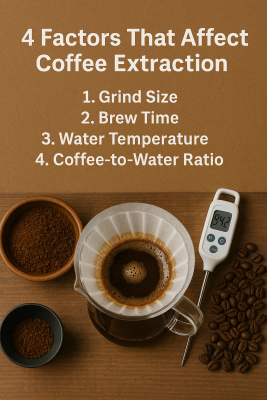The Science of Brewing the Perfect Cup of Coffee
Brewing coffee may feel like a daily ritual, but behind that warm cup is a complex process rooted in chemistry, physics, and sensory precision. Whether you’re a casual drinker or an aspiring barista, understanding the science behind coffee brewing can help you make better coffee every time. From water quality to grind size and extraction time, every variable influences flavor, aroma, and balance. Let’s explore what makes the perfect cup and how to replicate it consistently.
1. The Chemistry Behind Coffee Extraction
Coffee is essentially a chemical extraction. You’re dissolving hundreds of compounds from roasted coffee beans into hot water. This extraction process is where science plays a crucial role.
Solubles in Coffee Beans
Coffee beans contain soluble compounds that include acids, sugars, oils, caffeine, and aromatic compounds. The balance of these solubles is what gives coffee its flavor. But only around 30% of the bean is water-soluble, and out of that, 18–22% extraction is generally considered optimal for most brewing methods. Too little extraction and the coffee tastes sour and weak. Too much, and you risk bitterness.
Water: The Universal Solvent
Water quality is one of the most overlooked aspects of coffee brewing. Since coffee is over 98% water, impurities or imbalances in pH and mineral content directly affect flavor. Ideally, your water should be filtered and have a total dissolved solids (TDS) level between 75–250 ppm, with a near-neutral pH of 6.5–7.5. Hard or soft water can lead to over or under-extraction of certain flavor compounds.
Temperature Matters
Hot water speeds up the extraction process. However, too much heat can degrade delicate compounds and over-extract bitter notes. For most brews, water temperatures between 90°C and 96°C (195–205°F) are ideal. Below that, you may under-extract, while above that, you risk a burnt taste.
2. Precision Brewing: Tools and Techniques that Matter
To brew the perfect cup, you need control over three major variables: grind size, brew time, and brew ratio. Let’s break them down.
Grind Size: Surface Area in Action
Grind size determines how much surface area is exposed to water during brewing. The finer the grind, the quicker the extraction. Espresso, for instance, uses a fine grind to extract in just 25–30 seconds under pressure. French press, on the other hand, uses a coarse grind and a steeping method over several minutes.
Here’s a quick guide:
-
Espresso: Fine grind
-
Pour-over: Medium-fine grind
-
Drip coffee: Medium grind
-
French press: Coarse grind
-
Cold brew: Extra-coarse grind
Brew Time and Extraction Rate
The amount of time water is in contact with the coffee grounds determines how much is extracted. Short brew times require finer grinds, while longer brew times need coarser grinds to avoid over-extraction. Here’s a general idea:
-
Espresso: 25–30 seconds
-
Pour-over: 2.5–4 minutes
-
French Press: 4–5 minutes
-
Cold Brew: 12–24 hours
Brew Ratio: Getting the Balance Right
Brew ratio refers to the amount of coffee to water. A common starting point is 1:15 to 1:18 (1 gram of coffee to 15–18 grams of water), depending on personal taste. For example, a 20g dose of coffee to 300g of water (1:15) will produce a strong, bold cup. Precision digital scales are essential for consistency for The Science of Brewing the Perfect Cup of Coffee.
Pressure and Agitation
In espresso, pressure (9 bars ideally) is used to push water through finely ground coffee, which affects extraction time and crema formation. In manual brewing methods like pour-over or AeroPress, agitation (stirring or swirling) helps ensure even saturation of coffee grounds, aiding uniform extraction.
3. Variables That Influence Flavor and How to Control Them
Now that we’ve covered the core scientific aspects of brewing, let’s look at how to control specific variables to perfect your cup based on flavor preference.
Roast Level and Its Effects
Lighter roasts retain more of the bean’s origin characteristics—fruitiness, acidity, and floral notes—while darker roasts bring out chocolatey, smoky, and earthy flavors. Light roasts require more careful extraction due to higher acidity and denser beans. They often work better with pour-over or Chemex brewing. Dark roasts tend to be more forgiving and are ideal for espresso or French press.
The Importance of Freshness
Coffee is best consumed within 2–4 weeks of roasting and within 15 minutes of grinding. Once roasted, coffee beans start to oxidize and lose aromatic compounds. Pre-ground coffee loses flavor faster due to greater exposure to oxygen. Store whole beans in an airtight container, away from light and moisture.
Brewing Method and Flavor Profiles
Different methods highlight different flavor attributes:
-
Espresso: Intense, bold, syrupy. Good for those who enjoy concentrated flavors.
-
French Press: Full-bodied and rich. Great for earthy or chocolate-forward coffees.
-
Pour-over (e.g., V60 or Kalita): Clean, bright, and complex. Ideal for floral or fruity beans.
-
Cold Brew: Smooth and sweet with low acidity. A great choice for dark roasts.
Tasting and Adjusting
Learning to taste your coffee is essential. If it’s sour or acidic, increase brew time or grind finer. If it’s bitter, try a coarser grind or shorter brew time. Keeping a brewing journal can help track changes and improve consistency.
Final Thoughts
The science of brewing the perfect cup of coffee combines chemical knowledge, precise tools, and practice. By understanding extraction, grind size, temperature, and water quality, you can tailor every brew to match your flavor preferences. Remember, coffee is both an art and a science. So whether you’re pulling espresso shots or crafting a delicate pour-over, mastery lies in the details.
If you’re serious about quality, consider investing in a burr grinder, a digital scale, a thermometer, and a consistent brewing method. But most importantly—experiment. Your perfect cup of coffee is the one you love most.





